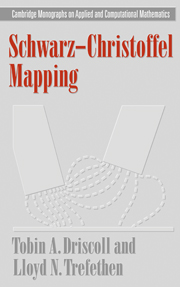4 - Variations
Published online by Cambridge University Press: 20 August 2009
Summary
A key aspect of the power of the Schwarz–Christoffel transformation (indeed, a large part of the motivation for this book) is its remarkable flexibility in adapting to a wide variety of situations, not all of which superficially seem to involve conformal maps or even polygons. The essence of SC mapping is to treat the corners exactly; if the rest of the problem is simple, nothing else is needed. What emerges from applications of this principle is that Schwarz–Christoffel mapping is not just a mapping technique but a distinctive way of thinking about problems of potential theory in the plane.
Let us reconsider the fundamental SC philosophy for constructing a map f (z). For the half-plane, we required f′ to have piecewise constant argument along the boundary because then the image under f has straight lines with corners. For other canonical domains, we need to modify this requirement slightly. For example, as we follow the boundary of the unit disk, a constant argument for f′ does not lead to a straight-line image. However, if g(z) is a function that “straightens out” the original domain boundary, then f′/g′ will have the appropriate piecewise-constant argument. This fact is especially convenient because we can also use powers of g(z) – g(zk) to create wedges that have the right jumps.
- Type
- Chapter
- Information
- Schwarz-Christoffel Mapping , pp. 41 - 74Publisher: Cambridge University PressPrint publication year: 2002



